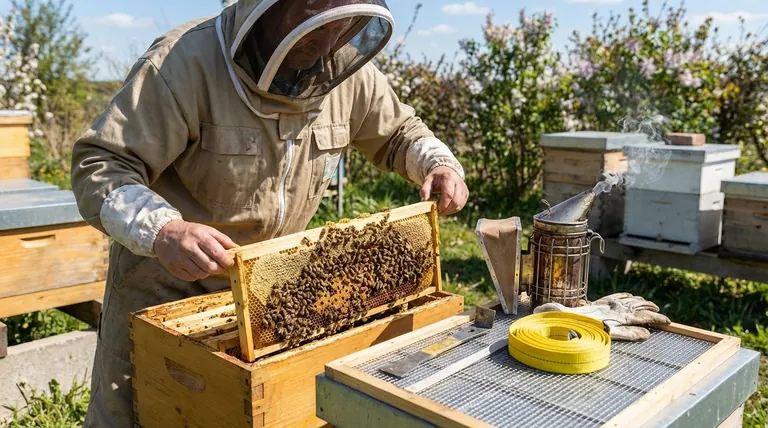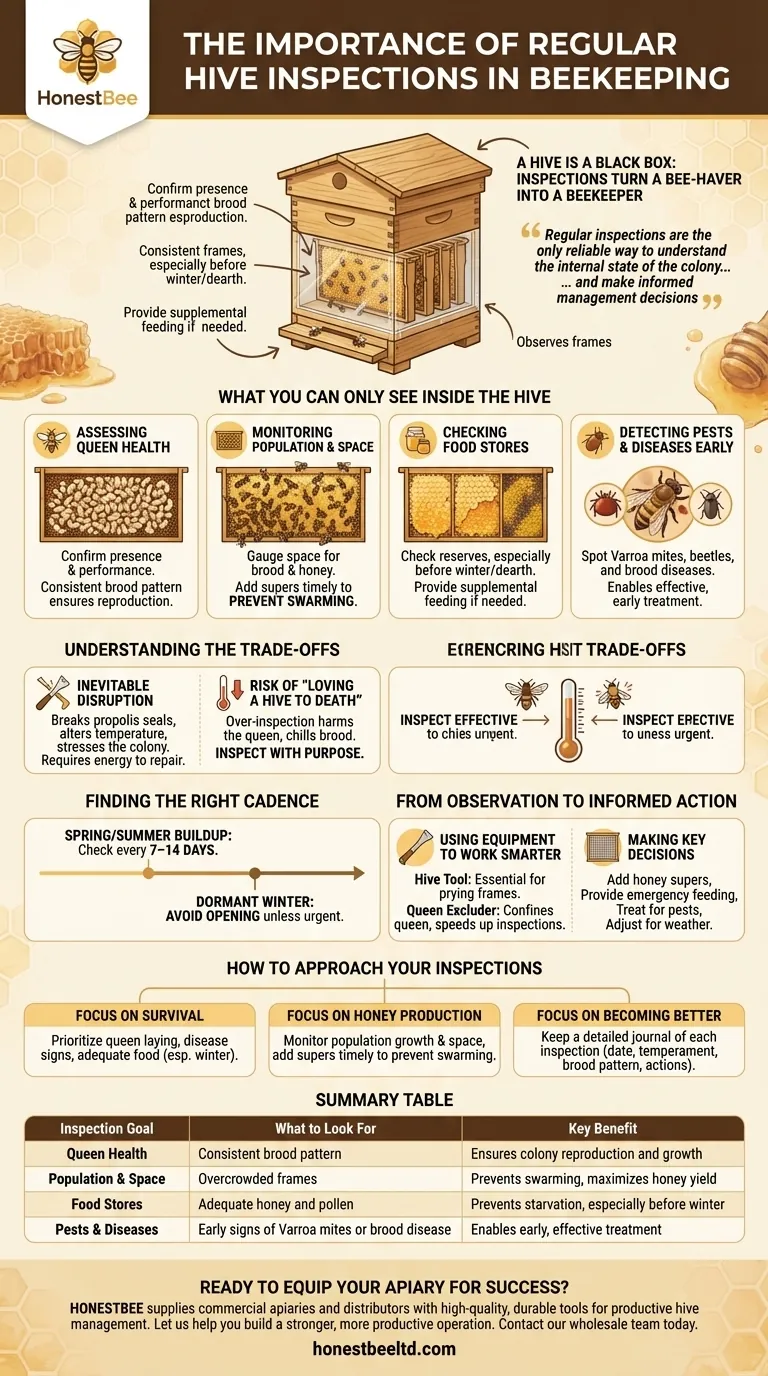For a beekeeper, a regular hive inspection is the single most important diagnostic tool you possess. Because bees are notoriously secretive, an inspection is the only reliable way to understand the internal state of the colony, assess its health, and make the informed management decisions necessary for its survival and productivity.
A hive is a black box; you cannot manage what you cannot measure. Regular inspections are your method for looking inside that box, turning you from a passive bee-haver into an active, effective beekeeper who can solve problems before they become catastrophes.

What You Can Only See Inside the Hive
From the outside, a busy hive entrance can mask serious internal problems. An inspection provides objective data on the four pillars of colony health.
Assessing the Queen's Health
The queen is the heart of the colony. A visual check of the brood frames is the only way to confirm her presence and performance.
You are looking for a consistent brood pattern, where eggs are laid in a dense, compact area. A spotty or scattered pattern can indicate a failing or sick queen.
Monitoring Colony Population and Space
A strong colony will steadily grow its population. During an inspection, you gauge whether the bees have enough space for the expanding brood nest and for storing honey.
If a hive becomes too crowded, the bees' natural response is to swarm, a process where the old queen leaves with about half the bees. Timely inspections allow you to add more space (supers) to prevent this.
Checking Food Stores
Bees require a significant amount of honey and pollen to survive and raise young. An inspection reveals the status of these crucial food reserves.
This is especially critical before winter or during a "nectar dearth" (a period with few flowering plants). Knowing their food status allows you to provide supplemental feeding if necessary.
Detecting Pests and Diseases Early
Pests like Varroa mites and small hive beetles can devastate a colony if left unchecked. Many brood diseases also only show symptoms inside the hive.
Regular inspections allow you to spot these threats in their early stages, when treatment is most effective and the colony has the best chance of recovery.
Understanding the Trade-offs
While essential, inspections are not without consequence. Understanding the balance is the mark of an experienced beekeeper.
The Inevitable Disruption
Every inspection is a major disruption. You break the propolis seals the bees have made, expose the brood nest to open air, and alter the hive's temperature and humidity.
This is a stressful event for the colony, and it takes them time and energy to repair the hive and restore order after you close it back up.
The Risk of "Loving a Hive to Death"
New beekeepers are often tempted to inspect too frequently out of enthusiasm or anxiety. This is a common mistake.
Over-inspection can harm the queen, chill the brood, and cause more stress than the colony can handle. The goal is to inspect with purpose, not just to look.
Finding the Right Cadence
The correct frequency for inspections changes with the season. During the spring and summer buildup, checking every 7 to 14 days is a good rule of thumb. In the dormant winter months, you should avoid opening the hive entirely unless an urgent issue is suspected.
From Observation to Informed Action
The data you gather during an inspection empowers you to perform specific management tasks that keep the hive healthy and productive.
Using Equipment to Work Smarter
A few essential tools make inspections effective and efficient. A hive tool is a simple metal bar used to pry apart hive boxes and lift frames sealed with propolis.
Equipment like a queen excluder—a grid that confines the larger queen to the lower brood boxes—can make inspections faster by ensuring you won't find eggs or brood in the upper honey supers.
Making Key Management Decisions
Based on your inspection, you can decide whether to add more honey supers, provide emergency feeding, treat for pests, or prepare the hive for changing weather by adjusting insulation or ventilation.
Without the direct knowledge from an inspection, these actions would be pure guesswork.
How to Approach Your Hive Inspections
Your goals as a beekeeper will help you prioritize what to look for during an inspection.
- If your primary focus is colony survival: Prioritize regular checks for the queen's laying pattern, signs of disease, and adequate food stores, especially before winter.
- If your primary focus is maximizing honey production: Pay close attention to population growth and available space, adding new supers just before the bees need them to prevent swarming.
- If your primary focus is becoming a better beekeeper: Keep a detailed journal of every inspection, noting the date, colony temperament, brood pattern, and actions taken to learn what works for your specific environment.
Ultimately, performing regular, purposeful inspections is the bridge between simply owning bees and actively, successfully keeping them.
Summary Table:
| Inspection Goal | What to Look For | Key Benefit |
|---|---|---|
| Queen Health | Consistent brood pattern | Ensures colony reproduction and growth |
| Population & Space | Overcrowded frames | Prevents swarming, maximizes honey yield |
| Food Stores | Adequate honey and pollen | Prevents starvation, especially before winter |
| Pests & Diseases | Early signs of Varroa mites or brood disease | Enables early, effective treatment |
Ready to equip your apiary for success?
Regular inspections are the foundation of effective beekeeping, and having the right supplies is crucial. At HONESTBEE, we supply commercial apiaries and beekeeping equipment distributors with the high-quality, durable tools needed for productive hive management—from essential hive tools to queen excluders and more.
Let us help you build a stronger, more productive operation. Contact our wholesale team today to discuss your equipment needs and receive a quote.
Visual Guide

Related Products
- Professional Galvanized Hive Strap with Secure Locking Buckle for Beekeeping
- Professional Drop-Style Hive Handles for Beekeeping
- Long Langstroth Style Horizontal Top Bar Hive for Wholesale
- Professional Engraved Round Hive Number Tags for Beekeeping
- Versatile Ratchet Hive Strap with S-Hooks for Secure Fastening
People Also Ask
- Can straps with hook ends be used for beehives? A Guide to Secure Hive Management
- What are hive straps and why are they used? Secure Your Hives Against Wind, Predators, and Transport
- What maintenance is required for hive straps? A Guide to Cam Buckle vs. Ratchet Strap Care
- What are the two styles of hive straps? Choose the Right Strap for Your Hive Security
- How can beekeepers secure the top cover of a hive? Protect Your Colony from Wind and Weather



















